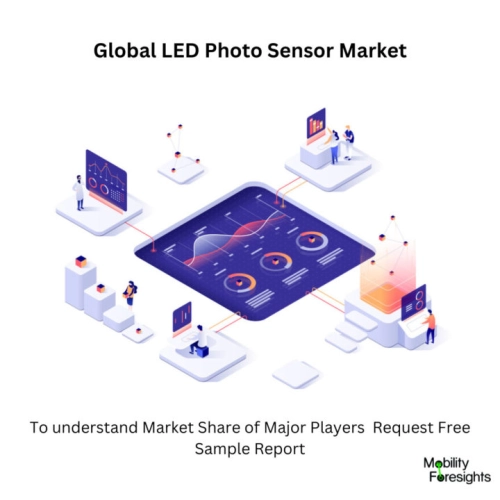
- Get in Touch with Us

Last Updated: Apr 25, 2025 | Study Period:
LED photo sensors, also known as photodetectors or light sensors, are devices that detect and measure light levels. They play a crucial role in various applications, from consumer electronics to industrial automation and beyond. These sensors work by converting light energy into an electrical signal, allowing them to respond to changes in light intensity.

The Global LED Photo SensorMarket accountedfor $XX Billion in 2023 and is anticipated to reach $XX Billion by 2030, registering a CAGR of XX% from 2024 to 2030.
| S No | Company Name | Development |
| 1 | OMNIVISION | New TheiaCel Technology and Automotive Image Sensor for LED-flicker-free Exterior Cameras are announced by OMNIVISION. The innovative technology improves automobile safety by delivering improved image quality and resolution in external cameras for autonomous driving (AD) and advanced driver assistance systems (ADAS). |
The OX08D10 is smaller than other external cabin sensors in its class and has industry-leading low light performance and low power consumption. It is the first image sensor to use OMNIVISION's innovative 2.1-micron TheiaCel technology, which uses the power of OMNIVISION's DCG high dynamic range (HDR) technology and next-generation lateral overflow integration capacitors to completely eliminate LED flicker regardless of lighting conditions.
The OX08D10 can record HDR images thanks to TheiaCel. This range is ideal for exterior camera applications in automobiles because it provides the best SNR1 and dynamic range balance.
With the introduction of the new OX08D10 image sensor, automotive OEMs now have a single component that combines all of the most crucial features, such as low-light performance, LED flicker mitigation (LFM), small size, and low power, removing the need for our customers to make performance or design sacrifices in order to address LED flicker.
Modern car image sensors must now incorporate LFM, HDR, and high resolution in order to attain increased levels of autonomy. These requirements are met by OMNIVISION's TheiaCel DCG + LOFIC solution, which is in line with the upcoming trend of adding more external cameras per car.
Flicker from LED traffic lights presents a significant challenge for image solutions in the automotive industry, making it difficult for ADAS and AD systems to accurately detect illuminated traffic signs. To solve this problem, the industry has been begging for a solution that could be quickly integrated into a CMOS image sensor.
While some previous methods produced satisfactory LFM, they also had poor image quality, especially in hot vehicle environments.TheiaCel, a new 2.1-m single-pixel technology from OMNIVISION, provides high LFM without compromising image quality.
TheiaCel makes use of the strengths of OMNIVISION's unique HDR technology and next-generation LOFIC to record situations with a very high contrast for the best possible content and image quality.
A greater dynamic range is achieved than with preceding single-exposure HDR architectures thanks to OMNIVISION's TheiaCel DCG + LOFIC technology.The new OX08D10 outperforms its non-LOFIC-based predecessor in particular in a number of critical areas.
It has improved cybersecurity in accordance with the most recent MIPI CSE version 2.0 requirements, which add functional safety to the data streams from automobile image sensors. For the smallest possible solution, the TheiaCel gadget uses OMNIVISION's a-CSP packaging technology.
| Sl no | Topic |
| 1 | Market Segmentation |
| 2 | Scope of the report |
| 3 | Abbreviations |
| 4 | Research Methodology |
| 5 | Executive Summary |
| 6 | Introduction |
| 7 | Insights from Industry stakeholders |
| 8 | Cost breakdown of Product by sub-components and average profit margin |
| 9 | Disruptive innovation in the Industry |
| 10 | Technology trends in the Industry |
| 11 | Consumer trends in the industry |
| 12 | Recent Production Milestones |
| 13 | Component Manufacturing in US, EU and China |
| 14 | COVID-19 impact on overall market |
| 15 | COVID-19 impact on Production of components |
| 16 | COVID-19 impact on Point of sale |
| 17 | Market Segmentation, Dynamics and Forecast by Geography, 2024-2030 |
| 18 | Market Segmentation, Dynamics and Forecast by Product Type, 2024-2030 |
| 19 | Market Segmentation, Dynamics and Forecast by Application, 2024-2030 |
| 20 | Market Segmentation, Dynamics and Forecast by End use, 2024-2030 |
| 21 | Product installation rate by OEM, 2024 |
| 22 | Incline/Decline in Average B-2-B selling price in past 5 years |
| 23 | Competition from substitute products |
| 24 | Gross margin and average profitability of suppliers |
| 25 | New product development in past 12 months |
| 26 | M&A in past 12 months |
| 27 | Growth strategy of leading players |
| 28 | Market share of vendors, 2024 |
| 29 | Company Profiles |
| 30 | Unmet needs and opportunity for new suppliers |
| 31 | Conclusion |
| 32 | Appendix |